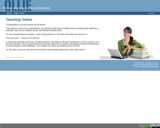
Teaching Online
- Subject:
- Education
- Material Type:
- Activity/Lab
- Reading
- Provider:
- AEA Learning Online
- Provider Set:
- OLLIE
- Author:
- Evan Abbey
- Date Added:
- 01/13/2021

Teaching Online
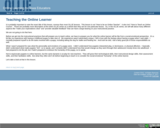
Teaching the Online Learner
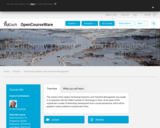
This version of the subject Technology Dynamics and Transition Management was taught in co-operation with the Harbin Institute of Technology in China. At the heart of this module lies a model of technology development from a social perspective, which will be applied to water problems in present-day China.
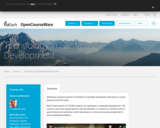
Next to their master all TU Delft students can specialise in sustainable development. This course is one of the requirements for the specialisation. It consists of a full-time week of guest lectures and workshops which takes place on a boat, and a group assignment to solve sustainable problems.
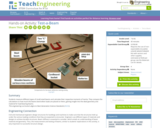
Students measure different types of small-sized beams and calculate their respective moments of inertia. They compare the calculations to how much the beams bend when loads are placed on them, gaining insight into the ideal geometry and material for load-bearing beams.

testing
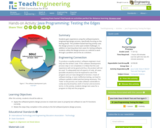
Students gain experience using the software/systems (engineering) design process, specifically focusing on the testing phase. This problem-based learning activity uses the design process to solve open-ended challenges. In addition to learning about test cases for testing software, students utilize the design process as a vehicle to work through a problem and arrive at a solution.
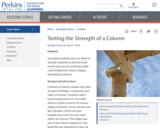
This activity was designed for blind learners, but all types of learners can use it to discover how much load can be carried by index cards folded into various shapes, resembling columns.

JUnit is a testing method that is included with NetBeans (Java) installs or can be downloaded from the web and included in the Java build. In this activity, students design tests for a provided Java class before the class methods are constructed using a process called test-driven development. To create a design, the software/system design process, which is a specific case of the engineering design process, is followed. After students create a design, it is implemented and tested and if necessary, the design undergoes editing to make sure it functions by testing the Java class correctly. To conclude the activity, students write the methods in the Java class using their tests to debug the program.
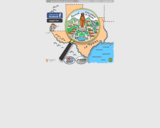
An online pedagogical reference grammar of the French language that combines authoritative grammar explanations, self-correcting exercises and online audio with surreal dialogues and cartoon images.
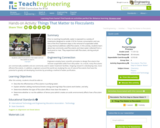
Prior to reaching households, water is exposed to a variety of treatments designed to render it fit for human consumption and use. One of the first treatment steps is the removal of suspended solids using chemical additives called flocculants. In this activity, students learn about two commonly used flocculants and clean water collected from a local pond or river. They experiment with flocculant, stirring and pH variables.
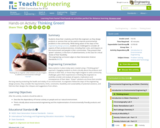
Students show their creativity and think like engineers as they design products or services that can be used to improve environmental problems in the community. While being aware of the steps of the engineering design process, students are challenged to consider all aspects of their products/services, including their costs, and impacts on the environment and people in their communities. They present their "green" solutions, in the form of advertisements, to the class for critical review of their feasibility.
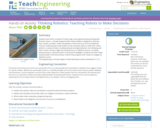
Students learn basic concepts of robotic logic and programming by working with Boe-Bot robotsâa simple programmable robotic platform designed to illustrate basic robotic concepts. Under the guidance of the instructor and a provided lab manual, student groups build simple circuits and write codes to make their robots perform a variety of tasks, including obstacle and light detection, line following and other motion routines. Eight sub-activities focus on different sensors, including physical sensors, phototransistors and infrared headlights. Students test their newly acquired skills in the final activity, in which they program their robots to navigate an obstacle course.

Student teams conduct an experiment that uses gold nanoparticles as sensors of chemical agents to determine which of four sports drinks has the most electrolytes. In this way, students are introduced to gold nanoparticles and their influence on particle or cluster size and fluorescence. They also learn about surface plasmon resonance phenomena and how it applies to gold nanoparticle technologies, which touches on the basics of the electromagnetic radiation spectrum, electrolyte chemistry and nanoscience. Using some basic chemistry and physics principles, students develop a conceptual understanding of how gold nanoparticles function. They also learn of important practical applications in biosensing.
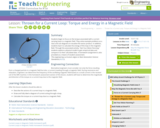
In this lesson, students begin to focus on the torque associated with a current carrying loop in a magnetic field. Students are prompted with example problems and use diagrams to visualize the vector product. In addition, students learn to calculate the energy of this loop in the magnetic field. Several example problems are included and completed as a class. A homework assignment is also attached as a means of student assessment.
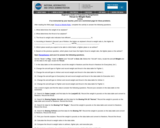
This resource, "Thrust to Weight Ratio Activity" is included in Lesson 1 Thrust which is a part of Unit 09 Aircraft Forces - Thrust included in ASA - Course 1 of the Aerospace & Mechanical Engineering subject area.
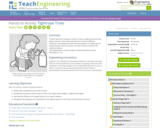
To learn about the concept of center of mass, students examine how objects balance. They make symmetrical cut-outs of different "creatures" and experiment with how they balance on a tightrope of string. Students see the concept of center of mass at work as the creatures balance.
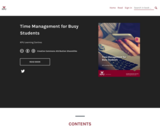
This workshop has been designed so that you can follow your own path. You will begin the workshop by taking a quiz to help you identify which path would be most helpful for you. After you complete the quiz and discover your results, click on the link to jump to your pathway. Pathway 1 is for students who would like some strategies to try and find some balance as they engage in studying while working. Pathway 2 is for new students who may be unfamiliar with how time at university differs from that of high school. Pathway 3 is for those who tend to put tasks off until the last minute and have come to realize that the strategy is not working for them.
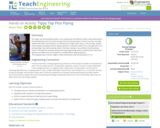
The Tippy Tap hand-washing station is an inexpensive and effective device used extensively in the developing world. One shortcoming of the homemade device is that it must be manually refilled with water and therefore is of limited use in high-traffic areas. In this activity, student teams design, prototype and test piping systems to transport water from a storage tank to an existing Tippy Tap hand-washing station, thereby creating a more efficient hand-washing station. Through this example service-learning engineering project, students learn basic fluid dynamic principles that are needed for creating efficient piping systems.

Tips I've Learned the Hard Way Designing in an LMS